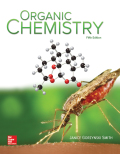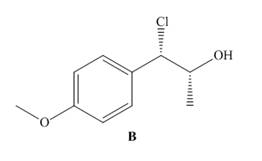
Concept explainers
Reaction of unknown A with

Want to see the full answer?
Check out a sample textbook solution
Chapter 14 Solutions
Organic Chemistry
Additional Science Textbook Solutions
Chemistry & Chemical Reactivity
Chemistry: The Molecular Nature of Matter
Essential Organic Chemistry (3rd Edition)
Chemistry
Chemistry: An Introduction to General, Organic, and Biological Chemistry (13th Edition)
- Treatment of 2-methylpropanenitrile [(CH3)2CHCN] withCH3CH2CH2MgBr, followed by aqueous acid, affords compound V, whichhas molecular formula C7H14O. V has a strong absorption in its IRspectrum at 1713 cm−1, and gives the following 1H NMR data: 0.91(triplet, 3 H), 1.09 (doublet, 6 H), 1.6 (multiplet, 2 H), 2.43 (triplet, 2 H), and2.60 (septet, 1 H) ppm. What is the structure of V?arrow_forwardA compound reacts with methylmagnesium bromide followed by acidification to form the product with the following 1H NMR spectrum. Identify thecompound.arrow_forward(a) The 'H-NMR spectrum of cyclobutanone shows two signals - signal A at 3.00 ppm and signal B at 1.95 ppm. Give the multiplicity of each signal. cyclobutanone (b) When cyclobutanone is treated with D20 and NaOD, the only signal observable in the 1H-NMR is a singlet at 2.00 ppm. Explain why this is the case. [Note: Deuterium atoms do not display signals in the TH-NMR spectrum]arrow_forward
- Treatment of 2-methylpropanenitrile [(CH3)2CHCN] with CH3CH2CH2MgBr, followed by aqueous acid, affords compound V, which has molecular formula C7H14O. V has a strong absorption in its IR spectrum at 1713 cm−1, and gives the following 1H NMR data: 0.91 (triplet, 3 H), 1.09 (doublet, 6 H), 1.6 (multiplet, 2 H), 2.43 (triplet, 2 H), and 2.60 (septet, 1 H) ppm. What is the structure of V? We will learn about this reaction in Chapter 20.arrow_forwardCompound K, molecular formula C6H14O, readily undergoes acid-catalyzed dehydration when warmed with phosphoric acid to give compound L, molecular formula C6H12, as the major organic product. The 1H-NMR spectrum of compound K shows signals at d 0.90 (t, 6H), 1.12 (s, 3H), 1.38 (s, 1H), and 1.48 (q, 4H). The 13C-NMR spectrum of compound K shows signals at d 72.98, 33.72, 25.85, and 8.16. Deduce the structural formulas of compounds K and L.arrow_forwardReaction of butanenitrile (CH3CH2CH2CN) with methylmagnesium bromide (CH3MgBr), followed by treatment with aqueous acid, forms compound G. G has a molecular ion in its mass spectrum at m/z = 86 and a base peak at m/z = 43. G exhibits a strong absorption in its IR spectrum at 1721 cm−1 and has the 1H NMR spectrum given below. What is the structure of G?arrow_forward
- Reaction of butanenitrile (CH3CH2CH2CN) with methylmagnesium bromide (CH3MgBr), followed by treatment with aqueous acid, forms compound G. G has a molecular ion in its mass spectrum at m/z = 86 and a base peak at m/z = 43. G exhibits a strong absorption in its IR spectrum at 1721 cm−1 and has the 1H NMR spectrum given below. What is the structure of G? We will learn about the details of this reaction in Chapter 22.arrow_forwardSketch and explain the IR, UV, mass, and NMR (1H and 13C) spectroscopy data of Benzonitrilearrow_forwardThe only organic compound obtained when compound Z undergoes the following sequence of reactions gives the 1H NMR spectrum shown.Identify compound Z.arrow_forward
- Compound I (C11H14O2) is insoluble in water, aqueous acid, and aqueous NaHCO3, but dissolves readily in 10% Na2CO3 and 10% NaOH. When these alkaline solutions are acidified with 10% HCl, compound I is recovered unchanged. Given this information and its 1H-NMR spectrum, deduce the structure of compound I.arrow_forwardAnethole, C10H12O, a major constituent of the oil of anise, has the 1H NMR spectrum shown. On oxidation with Na2Cr2O7, anethole yields p-methoxybenzoic acid. What is the structure of anethole? Assign all peaks in the NMR spectrum, and account for the observed splitting patterns.arrow_forwardRhodamine B is useful dye prepared in a manner very similar to fluorescein. Due to the nitrogen donating groups, rhodamine B absorbs 550 nm light and fluoresces 580 nm light. Provide a detailed mechanism for the formation of Rhodamine B from m-(diethylamino)phenol and phthalic anhydride in the presence of acid and heat.arrow_forward
 Organic ChemistryChemistryISBN:9781305580350Author:William H. Brown, Brent L. Iverson, Eric Anslyn, Christopher S. FootePublisher:Cengage Learning
Organic ChemistryChemistryISBN:9781305580350Author:William H. Brown, Brent L. Iverson, Eric Anslyn, Christopher S. FootePublisher:Cengage Learning

